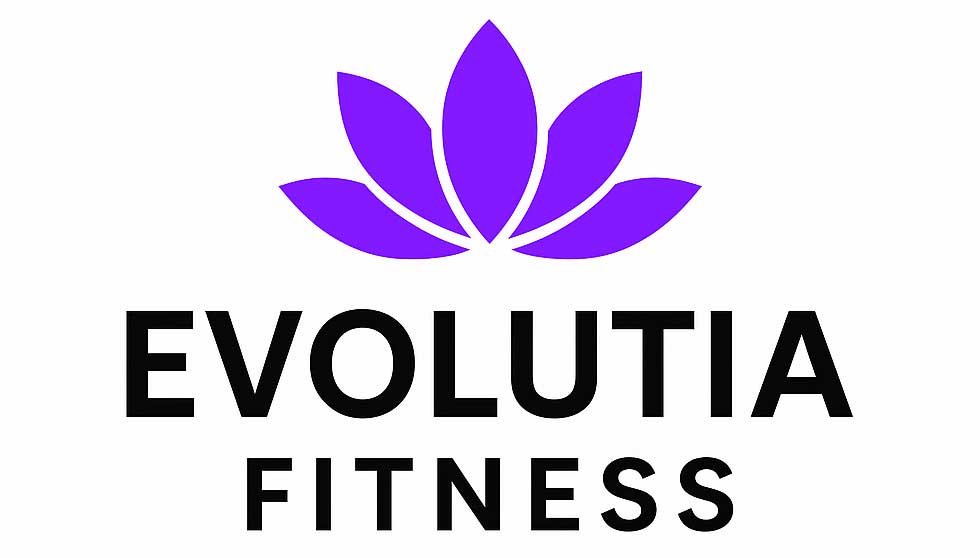As we age, maintaining balance becomes increasingly important for preventing falls and preserving independence. Yoga offers seniors a gentle yet effective way to improve stability, flexibility, and overall wellbeing. These six gentle yoga poses are specifically designed to help older adults enhance their balance while accommodating their unique physical needs.
Each pose can be modified to suit different mobility levels, making yoga accessible to seniors regardless of their fitness background. The mat tips provided alongside each pose ensure proper alignment and comfort, helping to prevent strain or injury during practice.
Regular practice of these balance-focused poses can help seniors build confidence in their movements both on and off the mat. The techniques shared in this article require minimal equipment and can easily be incorporated into a daily routine, making them practical options for older adults looking to improve their quality of life through movement.
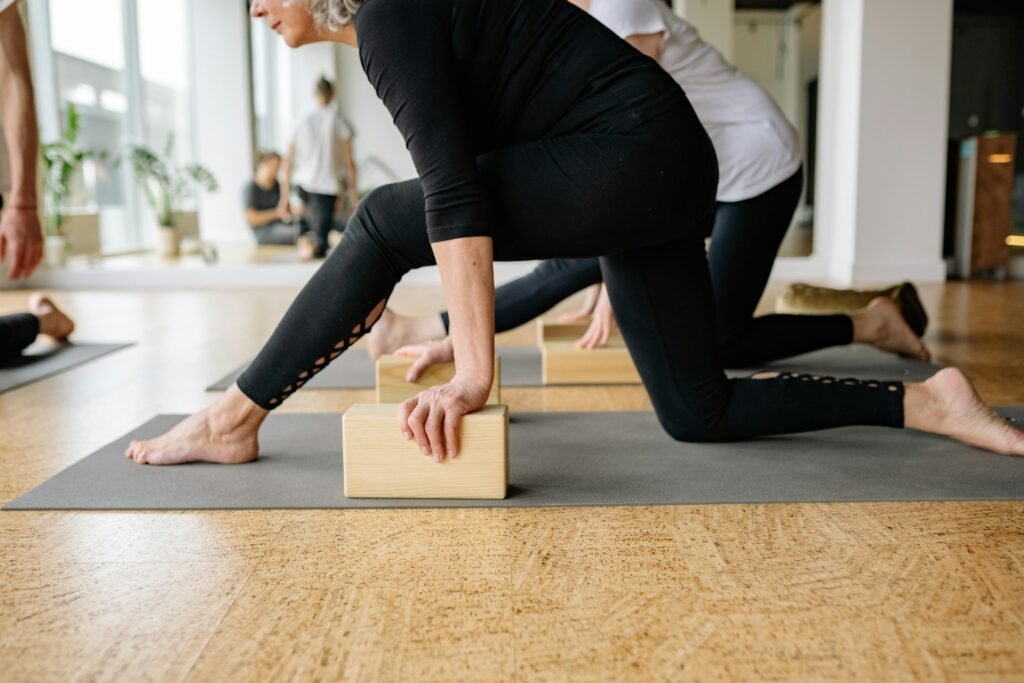
Table of Contents
The Importance of Balance for Seniors
Balance naturally declines as we age due to changes in our sensory systems, muscle mass, and nervous system function. According to the Centers for Disease Control and Prevention, more than one in four seniors experiences a fall each year, making balance issues a significant health concern.
Good balance is essential for maintaining independence and performing daily activities safely. Simple tasks like walking, climbing stairs, or getting up from a chair all require proper balance to prevent falls and injuries.
Falls represent the leading cause of injury (CDC) among adults aged 65 and older. They can result in serious consequences including broken bones, head injuries, and a decreased quality of life.
Key systems affecting balance in older adults:
- Vestibular system (inner ear)
- Vision
- Proprioception (body position awareness)
- Muscle strength
- Reaction time
Regular balance training through gentle yoga can help strengthen these systems and reduce fall risk by up to 23%, according to research published in the Journal of Gerontology.
Many seniors develop a fear of falling after experiencing a balance issue, which can lead to reduced activity and further physical decline. Breaking this cycle through safe, guided exercise is crucial.
Yoga specifically addresses balance by combining strength, flexibility, and mindfulness—all essential components for maintaining stability as we age.
Preparing for Your Yoga Practice
Proper preparation creates the foundation for a safe and effective senior yoga practice. The right equipment and environment can significantly reduce injury risk while enhancing comfort during poses.
How to Choose the Right Yoga Mat
Seniors benefit from thicker yoga mats that provide extra cushioning for sensitive joints. Look for mats between 6-8mm thick with non-slip surfaces to prevent accidents during practice.
Key features to consider:
- Texture: Mats with raised patterns offer better grip
- Material: Natural rubber or TPE mats provide superior support
- Length: Choose a mat at least 68 inches long for full body comfort
Some mats include alignment markers that help maintain proper positioning during poses. For seniors with mobility issues, mats with carrying straps or lightweight designs (under 3 pounds) make transportation easier.
Creating a Safe Yoga Practice Space
A dedicated yoga area free from obstacles helps prevent trips and falls. Choose a quiet space with good lighting and temperature control between 68-75°F for optimal comfort.
Position the mat on a flat, non-carpeted surface for stability. Allow at least 3 feet of clearance on all sides for movement during poses.
Keep these supportive props nearby:
- A sturdy chair for balance assistance
- 2 yoga blocks for modifying poses
- A blanket for joint cushioning
- A yoga strap for extending reach
Wall space can provide additional support for standing poses. Remove distractions like electronic devices, and ensure emergency contacts are accessible if practicing alone.
Gentle Yoga Poses for Enhanced Balance
Balance exercises play a vital role in maintaining stability and preventing falls as we age. These six foundational yoga poses specifically target balance while remaining accessible to seniors with varying mobility levels.
Mountain Pose (Tadasana)
Mountain Pose creates a strong foundation for all standing poses and helps improve posture. Stand with feet hip-width apart, distributing weight evenly across both feet.
Press all four corners of each foot firmly into the mat. Engage your thigh muscles slightly and draw your abdominal muscles in toward your spine.
Roll your shoulders back and down, extending your arms alongside your body with palms facing forward. Align your head over your heart and your heart over your pelvis.
Modification: Stand near a wall or chair for support if needed. Start with feet slightly wider for greater stability. Practice for 30-60 seconds, focusing on steady breathing and feeling grounded.
Tree Pose (Vrikshasana)
Tree Pose strengthens ankles, calves, and thighs while improving focus and balance. Begin in Mountain Pose near a wall or chair for support.
Shift your weight onto your right foot. Place your left foot on your right ankle, calf, or inner thigh (avoid pressing directly on the knee joint).
Keep your standing leg strong and your hips facing forward. Bring palms together at heart center or extend arms overhead like branches.
Key tip: Find a steady point to gaze at for better balance. If balance is challenging, try these modifications:
- Keep toes of raised foot touching the floor
- Use a chair or wall for support
- Practice near a corner where walls meet for dual support
Hold for 15-30 seconds, then repeat on the opposite side.
Warrior II (Virabhadrasana II)
Warrior II strengthens legs while improving hip flexibility and balance. Start with feet wide apart, about 3-4 feet.
Turn your right foot out 90 degrees and your left foot slightly inward. Align your right heel with the arch of your left foot.
Extend arms parallel to the floor with palms facing down. Bend your right knee directly over the ankle, keeping the shin perpendicular to the floor.
For seniors: Don’t bend the knee beyond 90 degrees. Keep the stance narrower initially for stability. Use a chair for support by placing one hand on the chair back.
Gaze over your right fingertips while keeping shoulders relaxed. Hold for 15-30 seconds, breathe steadily, then switch sides.
Chair Pose (Utkatasana)
Chair Pose builds strength in the lower body and core while improving balance. Stand with feet hip-width apart or slightly wider.
Inhale and raise arms overhead, keeping shoulders relaxed. Exhale and bend knees as if sitting in an imaginary chair.
Keep weight in the heels, not toes. Ensure knees stay behind toes and the tailbone lengthens toward the floor.
Senior-friendly tips:
- Use an actual chair for support
- Keep the bend minimal (just 30-45 degrees)
- Lower arms to shoulder height if raising them causes strain
- Practice against a wall for back support
Hold for 10-20 seconds initially, gradually working up to 30 seconds with consistent practice.
Downward-Facing Dog (Adho Mukha Svanasana)
This pose strengthens arms and shoulders while stretching the back of the legs. Begin on hands and knees with wrists under shoulders and knees under hips.
Press firmly through hands, tuck toes, and lift knees off the floor. Reach tailbone toward ceiling, creating an inverted V-shape with your body.
Keep knees bent initially if hamstrings are tight. Work toward straightening legs while keeping heels reaching toward the floor (they don’t need to touch).
Modifications for older adults:
- Use yoga blocks under hands for less wrist strain
- Practice at a wall with hands at waist height
- Keep knees bent generously
- Hold for shorter durations (10-15 seconds)
Focus on the lengthening sensation rather than achieving a perfect position.
Extended Triangle Pose (Utthita Trikonasana)
Triangle Pose improves balance while stretching the legs, hips, and spine. Start with feet wide apart (3-3.5 feet).
Turn right foot out 90 degrees and left foot in slightly. Extend arms parallel to floor with palms down.
Reach right arm forward, then hinge at the hip to bring right hand toward the shin, ankle, or a block placed outside the right foot.
Extend left arm toward ceiling in line with shoulders. Turn head to gaze at left hand, straight ahead, or down for neck comfort.
Senior-specific adaptations:
- Use a chair or wall for support
- Place a block under the lower hand
- Keep the stance narrower
- Focus on the hip hinge rather than reaching down far
Hold for 15-30 seconds while breathing steadily, then repeat on the opposite side.
Gentle Modifications and Supports for Each Pose
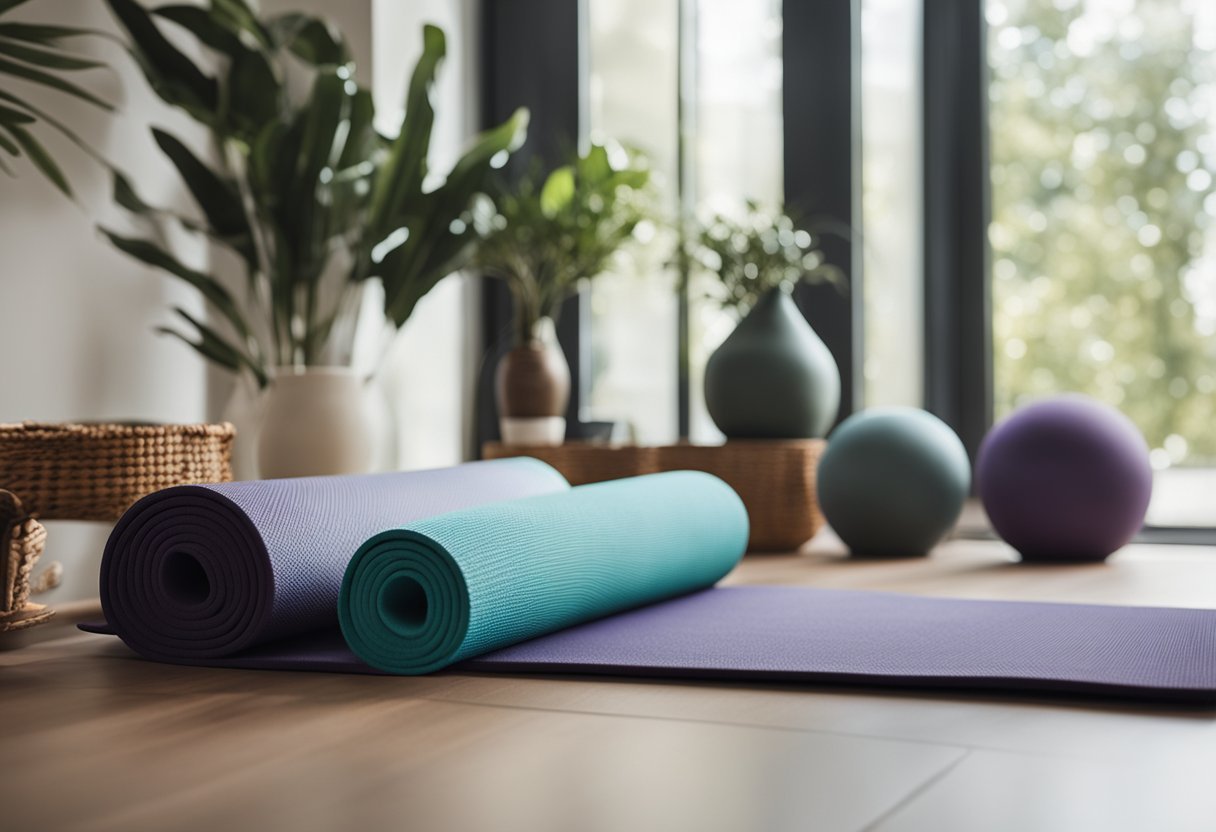
Proper modifications can make yoga accessible to seniors with varying mobility levels. For Mountain Pose, those with balance concerns can stand near a wall or chair for support. Seniors with foot pain may practice this pose while sitting.
Chair Pose modifications include using an actual chair instead of the traditional squat. Alternatively, practitioners can reduce the depth of their squat or place their back against a wall for added stability.
Tree Pose supports:
- Hold onto a wall or chair with one hand
- Keep the raised foot on the ankle instead of higher up
- Practice next to a sturdy surface for quick support if needed
For Warrior II, a wider stance increases stability while a narrower stance reduces strain. Those with knee sensitivity should ensure the bent knee doesn’t extend past the toes and may not bend as deeply.
Bridge Pose can be modified by placing a firm cushion under the hips for support. Seniors can also try a gentler version by keeping their arms alongside the body rather than clasped underneath.
Cat-Cow modifications:
- Perform on a chair if floor positions are challenging
- Use cushioned knee pads or a doubled-over mat
- Reduce the range of motion if there’s any discomfort
Props like yoga blocks, bolsters, and straps are invaluable tools for these modifications. A thicker, non-slip mat provides extra cushioning for sensitive joints and improved stability for all poses.
Breathing Techniques for Seniors
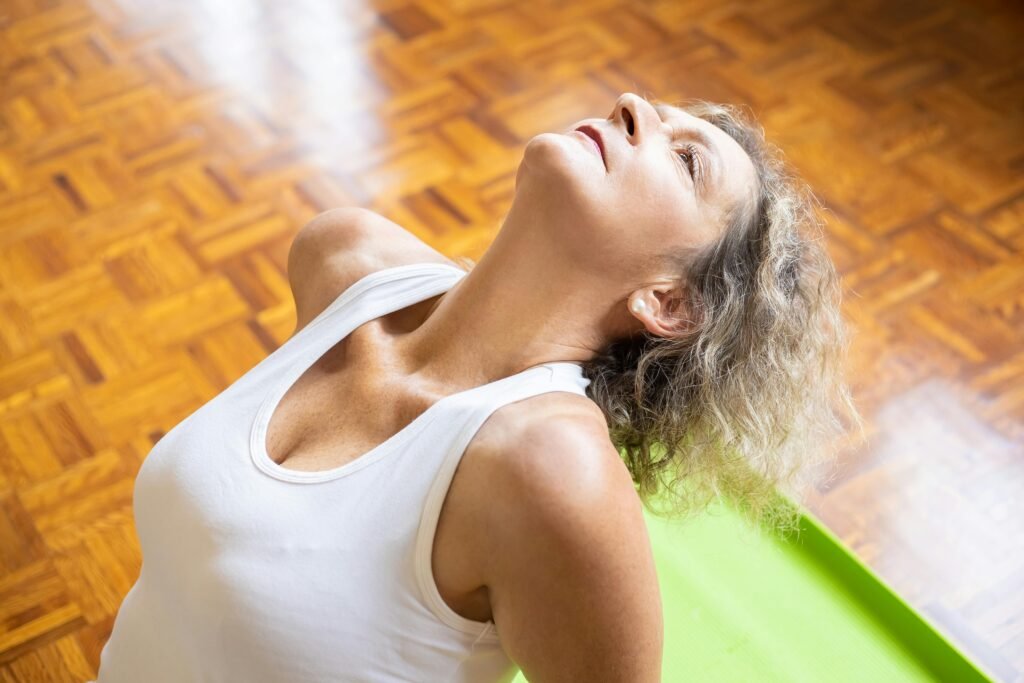
Proper breathing forms the foundation of an effective yoga practice, especially for seniors seeking to improve balance. Controlled breathing, or pranayama, enhances oxygen flow throughout the body and helps maintain stability during poses.
Deep Abdominal Breathing is an excellent technique for older adults to begin with. Place one hand on the chest and another on the abdomen, then inhale slowly through the nose, allowing the abdomen to expand. Exhale through the mouth, feeling the abdomen contract.
Seniors should aim to practice deep breathing for 3-5 minutes before attempting balance poses. This preparation activates the parasympathetic nervous system, reducing anxiety that might otherwise interfere with balance.
The 4-7-8 Breathing Technique has proven particularly beneficial for seniors:
- Inhale quietly through the nose for 4 counts
- Hold the breath for 7 counts
- Exhale completely through the mouth for 8 counts
- Repeat 3-4 times
Alternate Nostril Breathing helps balance the left and right hemispheres of the brain, improving concentration during balance poses. This technique involves closing one nostril with a finger while breathing through the other, then alternating sides.
For seniors with respiratory conditions, gentler approaches may be necessary. Always breathe at a comfortable pace, never forcing or straining. The quality of breath matters more than the duration.
When practicing balance poses, synchronizing breath with movement enhances stability. Inhale during expansive movements and exhale during contractions or challenging moments to maintain steadiness.
Incorporating Mindfulness and Meditation
Mindfulness and meditation naturally complement a senior yoga practice, enhancing both physical and mental benefits. These practices help seniors stay present and focused while performing gentle yoga poses, creating a deeper mind-body connection.
Adding just 5-10 minutes of meditation at the beginning or end of a yoga session can significantly reduce stress and anxiety. Seniors may notice improved sleep quality and enhanced cognitive function with regular practice.
Simple Mindfulness Techniques for Seniors:
- Focus on the breath for 2-3 minutes before beginning poses
- Practice body scanning while in resting poses
- Use guided meditation apps designed for older adults
- Incorporate gentle breathing exercises between poses
The combination of mindfulness with physical movement creates a powerful tool for emotional regulation. Many older adults report feeling more balanced emotionally after incorporating these practices into their routine.
Finding a comfortable seated position is essential for meditation practice. Using props like cushions or folded blankets can help seniors maintain proper posture without discomfort.
For those with mobility issues, meditation can be practiced in a chair or even while lying down. The goal is comfort and sustainability rather than adhering to traditional postures.
Consistency matters more than duration when beginning a mindfulness practice. Even brief daily sessions yield more benefits than occasional longer practices.
Building a Regular Yoga Routine
Consistency is the key to experiencing the full benefits of yoga for seniors. Aim to practice at least 2-3 times per week for 15-30 minutes per session, gradually increasing duration as strength and flexibility improve.
Morning sessions often work well for older adults, as the body is less stiff than later in the day. However, the best time to practice is whenever it fits consistently into your schedule.
Sample Weekly Schedule:
| Day | Activity |
|---|---|
| Monday | 20-minute balance sequence |
| Wednesday | 15-minute flexibility focus |
| Friday | 25-minute full routine |
| Weekend | Rest or gentle stretching |
Creating a dedicated space for practice helps establish the routine. Choose a quiet area with enough room for a mat and movement, preferably with natural light and minimal distractions.
Track progress with a simple journal noting how poses feel and any improvements in balance or mobility. This provides motivation and helps identify which poses deliver the most benefit.
Consider joining a senior yoga class at a local community center or online. Group settings offer accountability and social connection, both important factors for maintaining any fitness routine.
Remember that consistency trumps intensity. Short, regular sessions yield better results than occasional longer practices, especially for developing balance and preventing falls.
Benefits of Consistent Yoga Practice
Regular yoga practice offers numerous advantages for seniors beyond just physical flexibility. Research shows that consistent practice can significantly reduce fall risk by improving balance and coordination, essential skills for maintaining independence.
Improved Physical Function becomes evident within just a few weeks of regular practice. Many seniors report better mobility in daily activities like climbing stairs or getting up from chairs without assistance.
Yoga’s gentle movements help maintain bone density, particularly important for those at risk of osteoporosis. Weight-bearing poses create healthy stress on bones that stimulates regeneration.
Blood pressure management is another key benefit. Studies indicate that practicing yoga 2-3 times weekly can help lower systolic and diastolic readings in seniors with hypertension.
The practice supports better sleep quality too. Many practitioners experience deeper, more restorative sleep patterns after establishing a regular yoga routine.
Mental benefits are equally valuable. Regular yoga practice reduces anxiety and depression symptoms while promoting cognitive clarity. The mindfulness component helps seniors stay present and engaged.
Pain reduction, especially in joints and lower back, allows many seniors to reduce medication dependence. The gentle stretching releases tension in chronically tight areas without straining delicate tissues.
Social connections formed in yoga classes combat isolation, a common concern for older adults. Group practice creates community and accountability that sustains long-term engagement.
Safety Precautions and When to Consult Professionals
Safety should always be the top priority when practicing yoga, especially for seniors. Always warm up before attempting any pose to prepare the muscles and joints for movement.
Use props like chairs, walls, or modified poses when balance is a concern. Older adults should never force themselves into positions that cause pain or severe discomfort.
When to stop a yoga session immediately:
- Dizziness or lightheadedness
- Shortness of breath
- Chest pain
- Sharp or sudden pain in joints
- Extreme fatigue
It’s essential to move slowly between poses to maintain stability and prevent falls. Seniors should practice on non-slip yoga mats, preferably thicker ones that provide extra cushioning for sensitive joints.
Consultation with healthcare providers is necessary before beginning any yoga practice for those with:
- Recent surgeries
- Uncontrolled high blood pressure
- Heart conditions
- Severe osteoporosis
- Balance disorders
- Glaucoma or other eye conditions
Professional yoga instructors can provide valuable guidance for adapting poses to individual needs. Many communities offer specialized senior yoga classes taught by instructors with specific training in geriatric movement.
Consistent communication with both healthcare providers and yoga instructors ensures a safe practice. Seniors should inform their instructors about any health conditions or limitations before class begins.
Remember that progress in yoga is not measured by achieving perfect poses but by improvements in mobility, balance, and overall well-being.
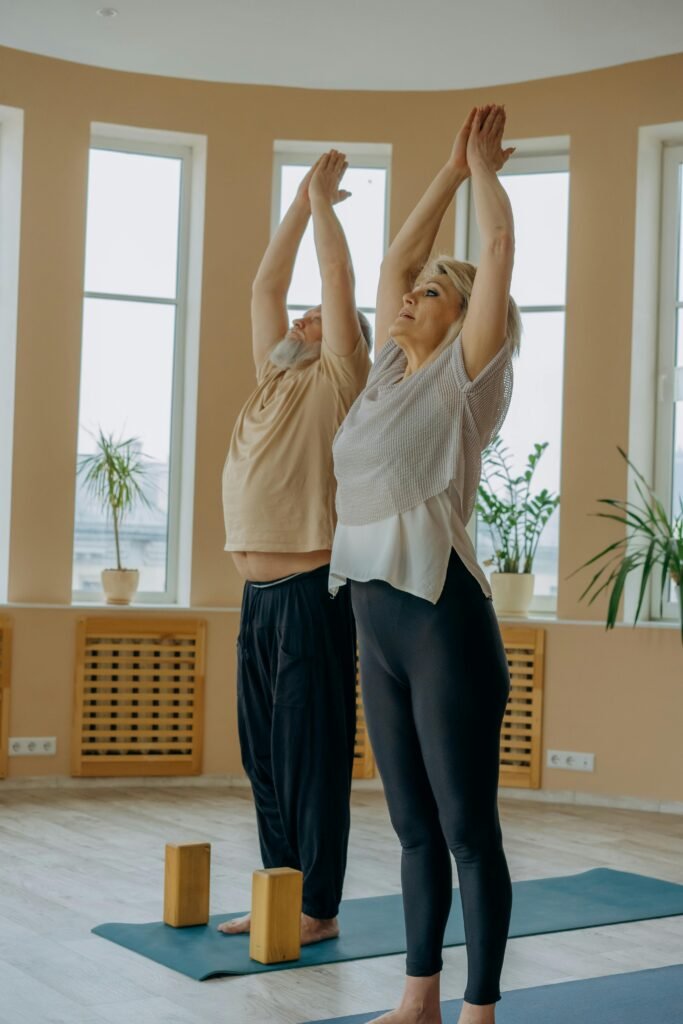
Frequently Asked Questions (FAQs)
Seniors exploring yoga for balance improvement often have specific concerns about safety, equipment, and technique. These questions address common inquiries about adapting yoga practice for older adults with different mobility levels and physical needs.
What are some safe yoga poses that seniors can practice for improving balance?
Tree Pose (Vrikshasana) offers excellent balance benefits when practiced near a wall or chair for support. Seniors can start with the foot placed against the ankle rather than higher on the leg.
Mountain Pose (Tadasana) serves as a fundamental standing posture that strengthens the legs and improves posture while being accessible to most ability levels.
Chair Pose (Utkatasana) performed with the support of an actual chair helps strengthen the quadriceps and glutes—muscles essential for stability and balance.
How can yoga mats be modified to assist seniors during balance exercises?
Thicker mats (8-10mm) provide additional cushioning for sensitive joints while still offering sufficient stability for balance poses. Some seniors benefit from mats with alignment markings to help with proper foot placement.
Non-slip mat surfaces with extra texture can prevent sliding, especially important for those with reduced grip strength. Mat extensions or yoga rugs can increase the practice surface area for seniors who need more space.
Placing the mat on a non-carpeted, flat surface ensures maximum stability during practice sessions.
Which gentle yoga postures help enhance stability and prevent falls in elderly individuals?
Warrior II (Virabhadrasana II) strengthens the legs while opening the hips and can be modified using a chair for support. The pose builds lower body strength crucial for stability during everyday movements.
Seated Spinal Twist (Ardha Matsyendrasana) improves spine mobility and core engagement, contributing to better overall balance even when performed from a chair.
Downward Facing Dog (Adho Mukha Svanasana) can be modified using a wall or countertop, helping to strengthen the upper body while stretching the hamstrings and calves.
What are the benefits of incorporating yoga into a senior’s daily routine for balance?
Regular yoga practice increases proprioception—the body’s awareness of its position in space—which directly translates to improved balance and reduced fall risk. Studies show consistent yoga practice can reduce fall frequency in seniors by up to 48%.
Yoga helps maintain and increase range of motion in joints, particularly in the ankles and hips, which are critical for stability and balance during daily activities.
The mindfulness component of yoga enhances cognitive function and reaction time, allowing older adults to respond more quickly to balance challenges in everyday situations.
How can yoga instructors adapt their sessions to accommodate seniors with limited mobility?
Instructors should offer chair-based alternatives for every standing pose, allowing participants to choose based on their comfort level. Props such as blocks, straps, and bolsters should be readily available and their use demonstrated for each pose.
Sequences should progress gradually, with longer holds and fewer transitions between poses to reduce fall risk. Classes for seniors benefit from smaller student-to-teacher ratios to ensure proper attention to alignment and safety.
Verbal cues should be clear and descriptive, focusing on anatomical landmarks rather than directional instructions that might cause confusion.
How do you ensure safety when seniors engage in yoga practices for balance?
Seniors should always perform a 5-10 minute warm-up focusing on gentle joint mobility before attempting balance poses. Those with osteoporosis should avoid forward folds and extreme spinal flexion, instead focusing on gentle extension and lateral movements.
Medical clearance is recommended before beginning yoga, especially for those with cardiovascular conditions, severe osteoporosis, or recent surgeries.
Balance poses should initially be practiced near a sturdy support like a wall or heavy chair that won’t slide, with gradual progression toward unsupported practice as confidence improves.
